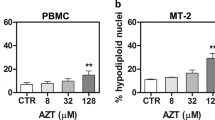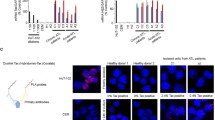Abstract
Adult T-cell leukemia/lymphoma (ATL) is a highly aggressive disease in which the human T-cell lymphotropic virus type I (HTLV-I) has been recognized as the etiologic agent. Fludarabine is a purine analog that has demonstrated significant activity in B-cell malignancies, including chronic lymphocytic leukemia and indolent non-Hodgkin’s lymphoma. This study explored the effects of fludarabine on HTLV-1-infected T cells (MT-1, -2, -4 and HUT102). Fludarabine induced growth arrest and apoptosis of these cells, as measured by 3-(4,5-dimethylithiazol-2-yl)-2,5-diphenyl tetrazolium bromide assay, cell cycle analysis and annexin V staining. Moreover, exposure of HTLV-1-infected T cells to fludarabine decreased the levels of X-inhibitor of apoptosis protein in conjunction with inhibition of nuclear factor κB (NF-κB)/DNA-binding activity, as measured by Western blot analysis and electrophoretic mobility shift and reporter gene assays, respectively. Further studies found that fludarabine accumulated NF-κB and inhibitory subunit of NF-κB in cytosole in conjunction with downregulation of NF-κB in nucleus, suggesting that fludarabine blocked nuclear translocation of NF-κB. Taken together, fludarabine may be useful for treatment of individuals with ATL and other types of cancer in which NF-κB plays a role.
This is a preview of subscription content, access via your institution
Access options
Subscribe to this journal
Receive 12 print issues and online access
$259.00 per year
only $21.58 per issue
Buy this article
- Purchase on Springer Link
- Instant access to full article PDF
Prices may be subject to local taxes which are calculated during checkout






Similar content being viewed by others
References
Hinuma Y, Nagata K, Hanaoka M, Nakai M, Matsumoto T, Kinoshita KI et al. Adult T-cell leukemia: antigen in an ATL cell line and detection of antibodies to the antigen in human sera. Proc Natl Acad Sci USA 1981; 78: 6476–6480.
Yoshida M, Miyoshi I, Hinuma Y . Isolation and characterization of retrovirus from cell lines of human adult T-cell leukemia and its implication in the disease. Proc Natl Acad Sci USA 1982; 79: 2031–2035.
Taguchi H, Kinoshita KI, Takatsuki K, Tomonaga M, Araki K, Arima N et al. An intensive chemotherapy of adult T-cell leukemia/lymphoma: CHOP followed by etoposide, vindesine, ranimustine, and mitoxantrone with granulocyte colony-stimulating factor support. J Acquir Immune Defic Syndr Hum Retrovirol 1996; 12: 182–186.
Yamada Y, Tomonaga M, Fukuda H, Hanada S, Utsunomiya A, Tara M et al. A new G-CSF-supported combination chemotherapy, LSG15, for adult T-cell leukaemia-lymphoma: Japan Clinical Oncology Group Study 9303. Br J Haematol 2001; 113: 375–382.
Keating MJ, Kantarjian H, Talpaz M, Redman J, Koller C, Barlogie B et al. Fludarabine: a new agent with major activity against chronic lymphocytic leukemia. Blood 1989; 74: 19–25.
Plunkett W, Gandhi V, Huang P, Robertson LE, Yang LY, Gregoire V et al. Fludarabine: pharmacokinetics, mechanisms of action, and rationales for combination therapies. Semin Oncol 1993; 20: 2–12.
Dasgupta RK, Rule S, Johnson P, Davies J, Burnett A, Poynton C et al. Fludarabine phosphate and melphalan: a reduced intensity conditioning regimen suitable for allogeneic transplantation that maintains the graft versus malignancy effect. Bone Marrow Transplant 2006; 37: 455–461.
Aggarwal BB . Nuclear factor-kappaB: the enemy within. Cancer Cell 2004; 6: 203–208.
Pikarsky E, Porat RM, Stein I, Avramovitch R, Amit S, Kasem S et al. NF-kappaB functions as tumor promoter in inflammation associated cancer. Nature 2004; 431: 461–466.
Baldwin Jr AS . The NF-κB and IκB proteins: new discoveries and insights. Annu Rev Immunol 1996; 14: 649–683.
Mori N, Yamada Y, Ikeda S, Yamasaki Y, Tsukasaki K, Tanaka Y et al. Bay 11-7082 inhibits transcription factor NF-kappaB and induces apoptosis of HTLV-1-infected T-cell lines and primary adult T-cell leukemia cells. Blood 2002; 100: 1828–1834.
Satou Y, Nosaka K, Koya Y, Yasunaga JI, Toyokuni S, Matsuoka M . Proteasome inhibitor, bortezomib, potently inhibits the growth of adult T-cell leukemia cells both in vivo and in vitro. Leukemia 2004; 18: 1357–1363.
Ikezoe T, Yang Y, Bandobashi K, Saito T, Takemoto S, Machida H et al. Oridonin, a diterpenoid purified from Rabdosia rubescens, inhibits the proliferation of cells from lymphoid malignancies in association with blockade of the NF-kappa B signal pathways. Mol Cancer Ther 2005; 4: 578–586.
Schimmer AD, Dalili S, Batey RA, Riedl SJ . Targeting XIAP for the treatment of malignancy. Cell Death Differ 2006; 13: 179–188.
Nishioka C, Takemoto S, Kataoka S, Yamanaka S, Moriki T, Shoda M et al. Serum level of soluble CD30 correlates with the aggressiveness of adult T-cell leukemia/lymphoma. Cancer Sci 2005; 96: 810–815.
Johnson SA . Use of fludarabine in the treatment of mantle cell lymphoma, Waldenstrom's macroglobulinemia and other uncommon B- and T-cell lymphoid malignancies. Hematol J 2004; 5 (Suppl 1): S50–S61.
Pahler JC, Ruiz S, Niemer I, Calvert LR, Andreeff M, Keating M et al. Effects of the proteasome inhibitor, bortezomib, on apoptosis in isolated lymphocytes obtained from patients with chronic lymphocytic leukemia. Clin Cancer Res 20031; 9: 4570–4577.
Kelley TW, Alkan S, Srkalovic G, Hsi ED . Treatment of human chronic lymphocytic leukemia cells with the proteasome inhibitor bortezomib promotes apoptosis. Leuk Res 2004; 28: 845–850.
Faderl S, Rai K, Gribben J, Byrd JC, Flinn IW, O'brien S et al. Phase II study of single-agent bortezomib for the treatment of patients with fludarabine-refractory B-cell chronic lymphocytic leukemia. Cancer 2006; 107: 916–924.
Quaglino P, Fierro MT, Rossotto GL, Savoia P, Bernengo MG . Treatment of advanced mycosis fungoides/Sezary syndrome with fludarabine and potential adjunctive benefit to subsequent extracorporeal photochemotherapy. Br J Dermatol 2004; 150: 327–336.
Go RS, Gazelka H, Hogan JD, Wester SM . Subcutaneous panniculitis-like T-cell lymphoma: complete remission with fludarabine. Ann Hematol 2003; 82: 247–250.
Frank DA, Mahajan S, Ritz J . Fludarabine-induced immunosuppression is associated with inhibition of STAT1 signaling. Nat Med 1999; 5: 444–447.
Klotz L, Schmidt M, Giese T, Sastre M, Knolle P, Klockgether T et al. Proinflammatory stimulation and pioglitazone treatment regulate peroxisome proliferator-activated receptor gamma levels in peripheral blood mononuclear cells from healthy controls and multiple sclerosis patients. J Immunol 2005; 175: 4948–4955.
Acknowledgements
This work was supported in part by Grant-in-Aid from the Ministry of Education, Culture Sports, Science, and Technology of Japan (to T.I), Public Trust Haraguchi Memorial Cancer Research Fund (to T.I) and Uehara Memorial Foundation (to T.I). HPK is supported by NIH grants as well as the Inger Fund.
Author information
Authors and Affiliations
Corresponding author
Rights and permissions
About this article
Cite this article
Nishioka, C., Ikezoe, T., Yang, J. et al. Fludarabine induces apoptosis of human T-cell leukemia virus type 1-infected T cells via inhibition of the nuclear factor-κB signal pathway. Leukemia 21, 1044–1049 (2007). https://doi.org/10.1038/sj.leu.2404622
Received:
Revised:
Accepted:
Published:
Issue Date:
DOI: https://doi.org/10.1038/sj.leu.2404622
Keywords
This article is cited by
-
Imatinib causes epigenetic alterations of PTEN gene via upregulation of DNA methyltransferases and polycomb group proteins
Blood Cancer Journal (2011)
-
Long-term exposure of leukemia cells to multi-targeted tyrosine kinase inhibitor induces activations of AKT, ERK and STAT5 signaling via epigenetic silencing of the PTEN gene
Leukemia (2010)
-
Inhibition of MEK/ERK signaling induces apoptosis of acute myelogenous leukemia cells via inhibition of eukaryotic initiation factor 4E-binding protein 1 and down-regulation of Mcl-1
Apoptosis (2010)
-
A novel treatment strategy targeting polo-like kinase 1 in hematological malignancies
Leukemia (2009)
-
Analysis of Aurora B kinase in non-Hodgkin lymphoma
Laboratory Investigation (2009)



